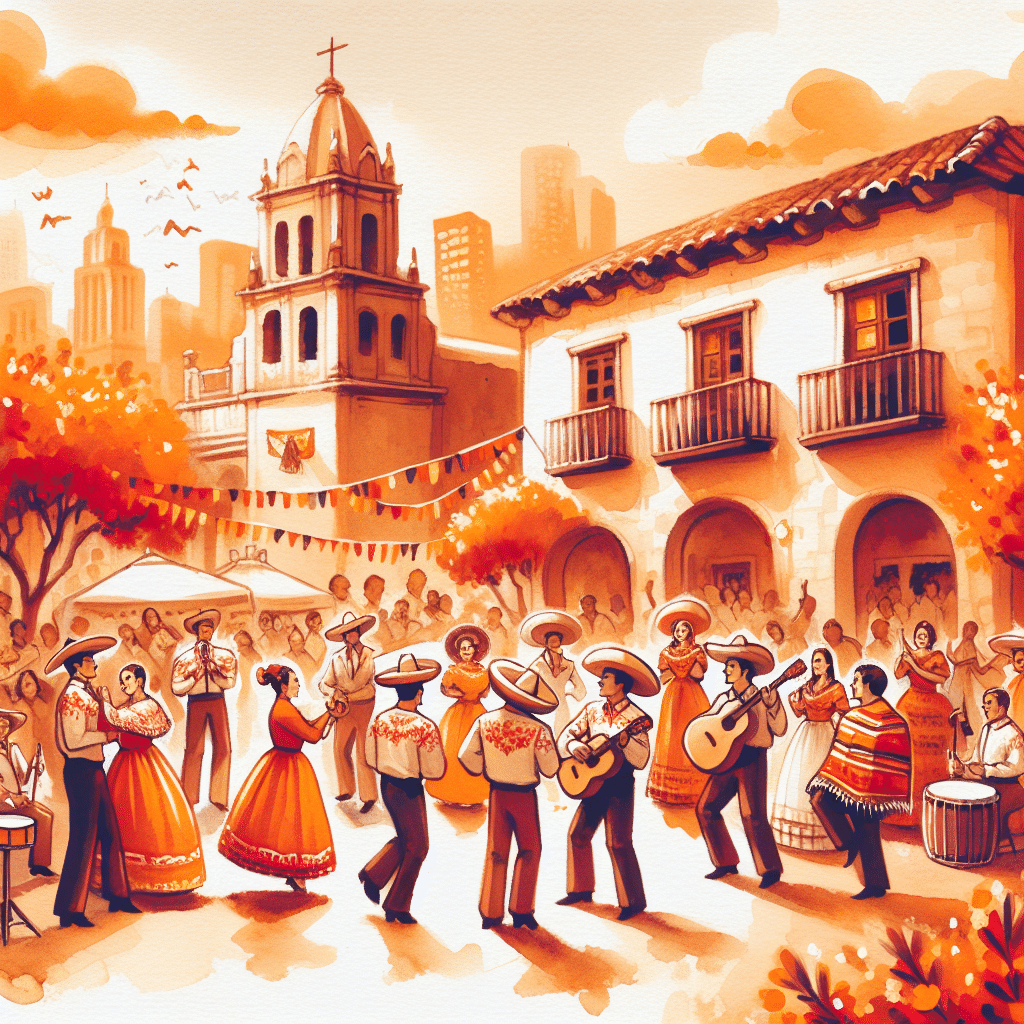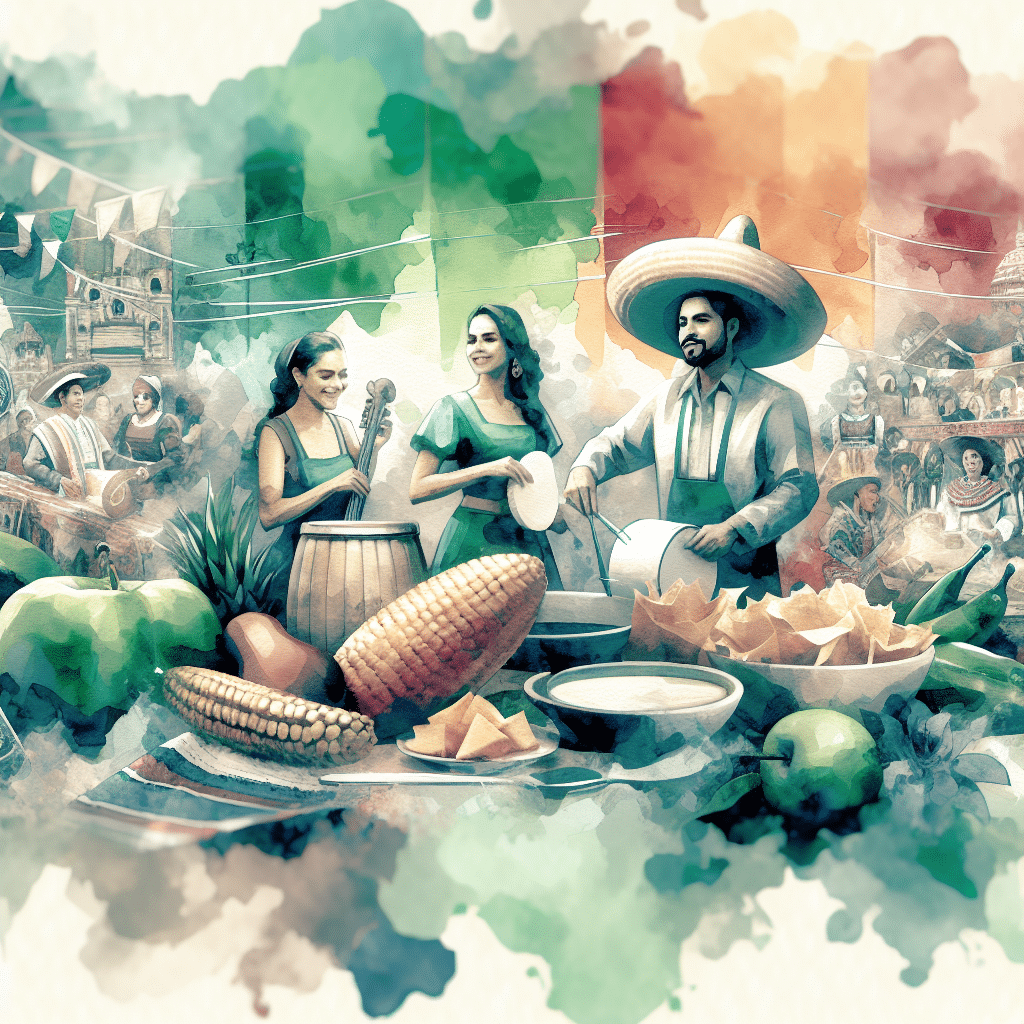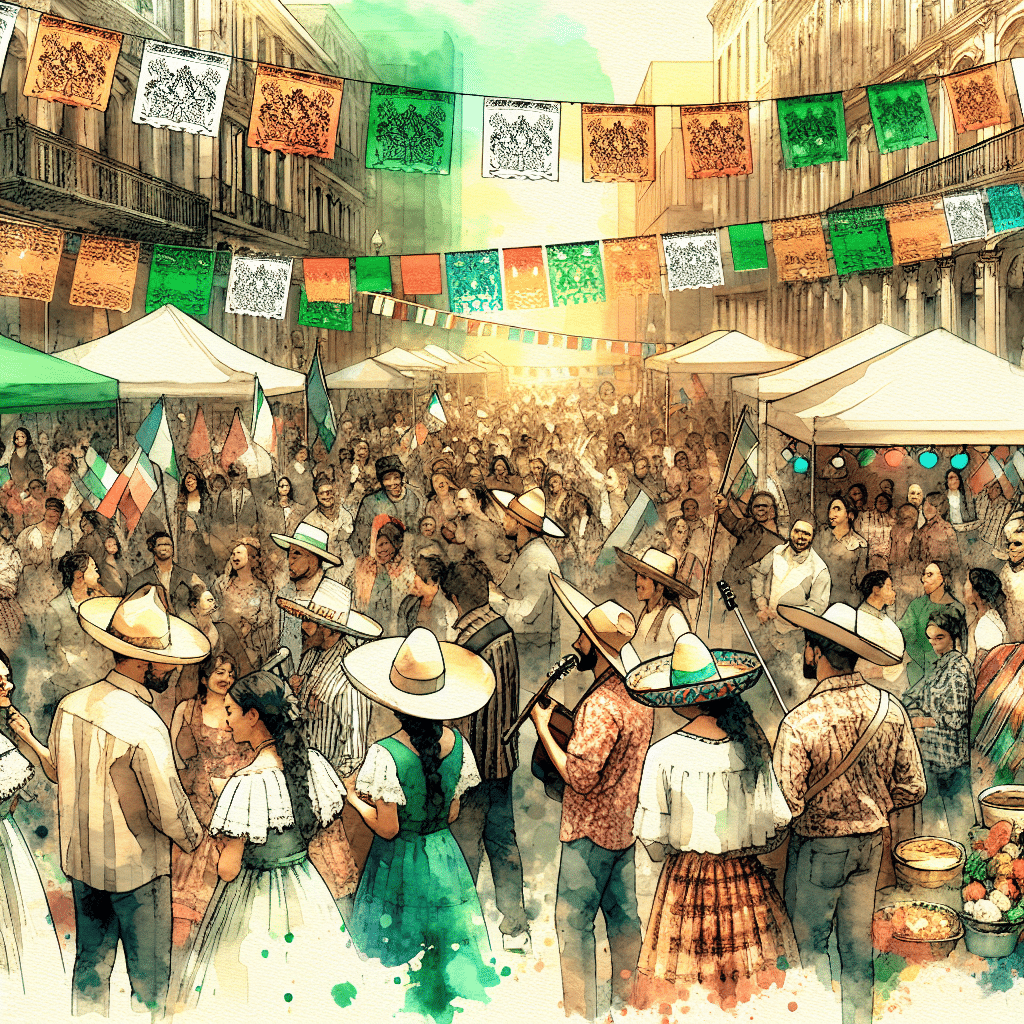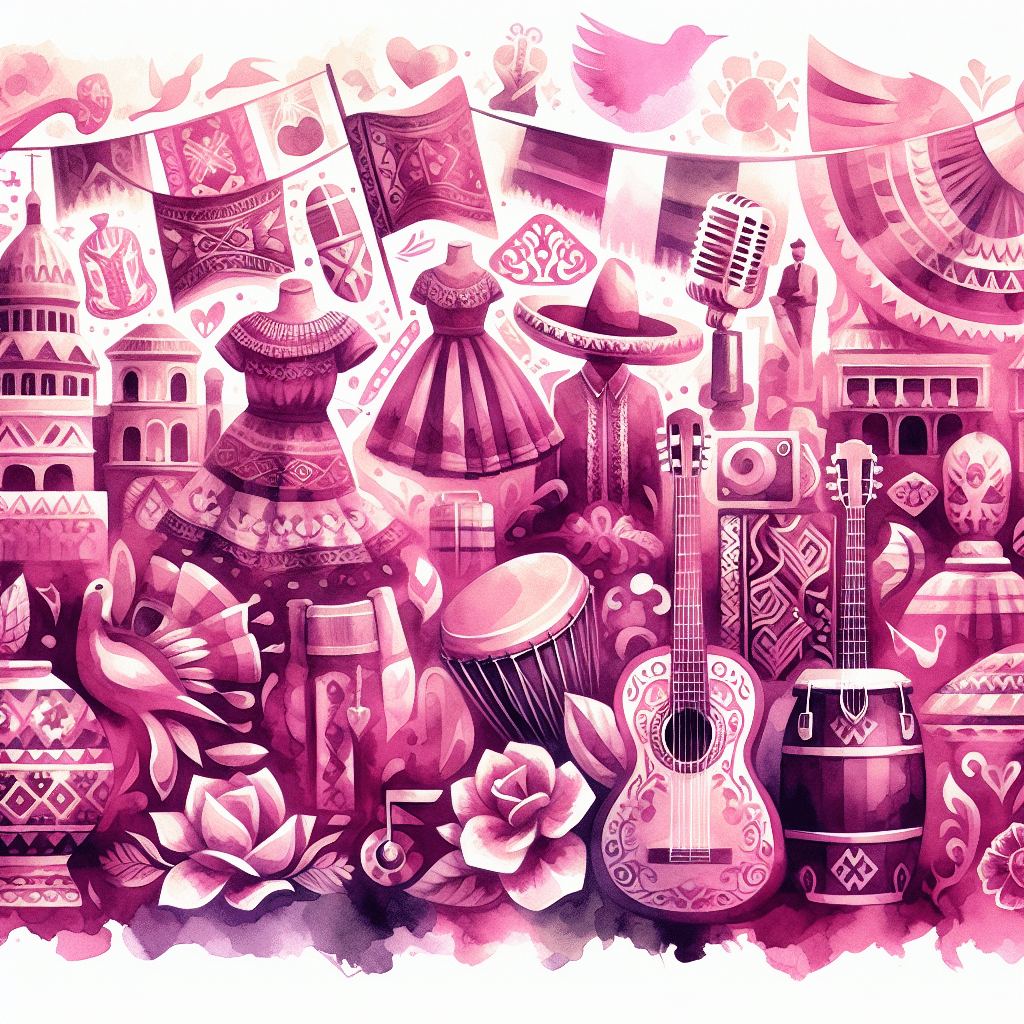
Latino Traditions: Celebrations, Cuisine, and Cultural Heritage
Latino Traditions and Celebrations
Influence of Indigenous Culture
Latin America is a treasure chest of traditions, and a big part of its charm comes from indigenous cultures. These cultures have left their mark on art, crafts, architecture, and social life. Think about stunning pottery, intricate textiles, and jewelry that could make even Cleopatra green with envy. And let’s not forget the jaw-dropping architectural wonders like Machu Picchu that still leave us speechless (Wikipedia).
Take the Aztec civilization, for example. They didn’t just give us chocolate (thank you, Aztecs!), but also spiced up modern Mexican cuisine with salt, chili peppers, and honey. Their traditions, dances, myths, and religious practices like Día de los Muertos (Day of the Dead) are still celebrated today (Eclipse di Luna). Día de los Muertos is a fiesta you can’t miss. It’s a lively celebration where families honor their deceased loved ones with altars, marigolds, and sugar skulls. For more on this, check out latino religious festivals.
Evolution of Latin American Music
Ever found yourself moving to the beat of salsa, merengue, or reggaeton? You can thank Latin American music for that. This music is as varied as the region itself, blending indigenous, Spanish, African, and other influences into rhythms that make you want to dance all night. Instruments like the marimba, guitar, harp, and cajón create sounds that are both unique and captivating (Wikipedia).
But Latin American music isn’t just for parties. It’s a rich mix of history and culture, reflecting the struggles and joys of its people. From the soulful tunes of bolero to the energetic beats of samba, there’s something for everyone. And let’s not forget Carnaval, the ultimate party, celebrated across Latin America between January and March. This festival is a blend of indigenous rituals and European traditions, filled with color, music, and costumes that make Mardi Gras look like a quiet night in. For more on Carnaval, head over to festivals in Latin America.
So, whether you’re grooving to a Latin beat or marveling at ancient architecture, the influence of indigenous culture and the evolution of Latin American music make these Latino celebrations truly magical. Jump into the fiesta and experience it all for yourself!
Culinary Delights of Latin America
Latin America is a food lover’s paradise where flavors groove like they’re at a salsa party. Let’s dig into two culinary stars: Peruvian fusion and Venezuelan heritage.
Peruvian Cuisine Fusion
Peruvian cuisine is like the ultimate remix, blending Amerindian and Spanish food with African, Arab, Italian, Chinese, and Japanese influences. Think ceviche that’s fresher than your morning coffee or anticuchos that pack a punch like your favorite dance track. Peru’s diverse climates make this fusion magic possible.
Here’s a taste of what you might find on a Peruvian menu:
| Dish | Key Ingredients | Flavor Profile |
|---|---|---|
| Ceviche | Fresh fish, lime juice, onions, cilantro | Fresh, tangy, and spicy |
| Anticuchos | Grilled beef heart, vinegar, garlic, aji pepper | Smoky, savory, and spicy |
| Humitas | Ground corn, cheese, and spices wrapped in corn husks | Sweet or savory, soft and buttery |
| Pachamanca | Various meats, potatoes, and vegetables cooked in an earthen oven | Earthy, rich, and hearty |
Food in Peru is more than just a meal; it’s a celebration of cultural identity and heritage. For more on traditional Latino food traditions, check out our Latin American holiday traditions.
Venezuelan Culinary Heritage
Venezuelan cuisine is a flavorful reflection of its multicultural roots, shaped by indigenous, African, and European Spanish traditions. Picture arepas as versatile as your wardrobe, and hallacas that are as complex as a telenovela plot twist.
Explore some Venezuelan delights:
| Dish | Key Ingredients | Flavor Profile |
|---|---|---|
| Arepas | Ground maize dough, can be filled with meats, cheeses, or avocados | Versatile, can be savory or sweet |
| Pabellón Criollo | Shredded beef, black beans, rice, and plantains | Savory, hearty, slightly sweet |
| Hallacas | Corn dough stuffed with a stew of beef, pork, chicken, and olives, wrapped in plantain leaves | Complex, rich, and festive |
| Cachapas | Corn pancakes often topped with cheese or ham | Sweet and savory |
Venezuelan food traditions have long inspired American cuisine, adding to the rich tapestry of flavors we enjoy today. For more on how these culinary delights have crossed borders, visit our page on Latino culinary influence.
Both Peruvian and Venezuelan cuisines are not just about feeding the body; they’re about feeding the soul. Whether you’re diving into a plate of ceviche or savoring an arepa, remember that these dishes are a testament to the vibrant and diverse cultural heritage of Latin America. For more on Latino cultural events and heritage, check out our section on Hispanic cultural events.
Key Latino Festivals
Latino culture is bursting with lively and colorful celebrations that are steeped in tradition. Two of the most iconic festivals are Dia De Los Muertos (Day of the Dead) and Carnaval Celebrations. These events aren’t just parties; they’re a way to honor heritage, family, and life itself.
Dia De Los Muertos (Day of the Dead)
Dia De Los Muertos, celebrated on November 2nd, is a major traditional Latino celebration. This Mexican holiday mixes indigenous rituals and Catholic beliefs, creating a unique cultural event. Despite its spooky name, the Day of the Dead is a joyful occasion honoring deceased loved ones.
In Mexico, the festivities involve large events, parade floats, and elaborate costumes with skeleton makeup. The best place to experience the celebration is in Mexico City, but it takes place throughout the country (GoWay). Families create altars (ofrendas) adorned with marigolds, candles, and favorite foods of the departed to welcome their spirits back to the world of the living.
| Key Elements | Description |
|---|---|
| Date | November 2nd |
| Main Activities | Parades, altars, offerings, skeleton costumes |
| Best Location | Mexico City |
| Cultural Significance | Honors deceased loved ones |
For more on religious and cultural celebrations, check out our page on Latino religious festivals.
Carnaval Celebrations
Carnaval is a huge holiday in many Latin American countries, celebrated between January and March. This festival is a blend of indigenous rituals and European traditions, and it’s one of the most anticipated events of the year. Pre-Columbian civilizations marked the changing of seasons with festivals, while European colonizers introduced Lenten traditions. The fusion of these elements gave rise to Carnaval, a vibrant celebration filled with color, music, costumes, and a joyful spirit (Eclipse di Luna).
In Mexico, Carnaval is celebrated on March 5th and kicks off a five-day celebration before Lent. The festivities include parades, floats, and dancing in the streets (UCANR). Meanwhile, Brazil hosts the world’s biggest Mardi Gras party, starting on the last Friday before Lent. The Rio de Janeiro Carnival peaks around the Sambadrome, featuring song, dance, and elaborate costumes.
| Country | Dates | Main Activities | Notable Locations |
|---|---|---|---|
| Mexico | March 5th | Parades, floats, dancing | Veracruz |
| Brazil | Last Friday before Lent | Sambadrome parade, parties | Rio de Janeiro |
| Argentina | January-March | Parades, music, costumes | Gualeguaychú |
| Bolivia | January-March | Traditional dances, costumes | Oruro |
For more on how these celebrations influence culture globally, visit our section on festivals in Latin America.
These festivals are a testament to the rich and diverse heritage of Latin America, blending history, culture, and a whole lot of fun. Whether you’re donning skeleton makeup or dancing in a parade, these traditional Latino celebrations offer an unforgettable experience.
Global Impact of Latino Culture
Latino culture has left a huge mark on the world, especially in food and celebrations. Let’s see how traditional Latino celebrations and cuisine have made their mark worldwide.
Latino Culinary Influence
Latino food traditions have spiced up American cuisine with core ingredients like corn, meat, beans, and rice. These flavors are a hit worldwide (Smithsonian Latino Center). From tacos to tamales, Latino dishes have become a favorite in the U.S., adding to the evolution of American food.
| Dish | Origin | Popularity in the US |
|---|---|---|
| Tacos | Mexico | High |
| Pupusas | El Salvador | Medium |
| Arepas | Venezuela | Medium |
| Ceviche | Peru | High |
| Empanadas | Argentina | Medium |
You can’t miss the Latino food influence in the U.S. From street vendors to fancy restaurants, Latino dishes are everywhere. This mix of flavors celebrates the rich heritage of Latino culture.
For more on the culinary delights of Latin America, check out our sections on Peruvian Cuisine Fusion and Venezuelan Culinary Heritage.
Cultural Celebrations Beyond Borders
Latino cultural celebrations have spread across the globe, bringing vibrant traditions to new audiences. One notable celebration is Día de los Reyes Magos, or Three Kings’ Day, celebrated on January 6th in many Catholic countries. This day is marked by gift-giving and festive gatherings.
Another big celebration is Carnaval, a Mexican holiday celebrated with parades, floats, and street dancing. This five-day party kicks off just before Catholic Lent (UCANR).
| Festival | Country of Origin | Global Celebrations |
|---|---|---|
| Día de los Reyes Magos | Spain | Latin America, US |
| Carnaval | Brazil | Worldwide |
| Día de los Muertos | Mexico | US, Europe |
| Semana Santa | Spain | Latin America, US |
Carnaval in Brazil is the world’s biggest Mardi Gras party, starting on the last Friday before Lent. This festival features song, dance, and elaborate parade floats, peaking around the Sambadrome in Rio de Janeiro (GoWay).
For more information on Latino festivals, explore our sections on Dia De Los Muertos (Day of the Dead) and Carnaval Celebrations.
Latino culture’s global influence is vast and vibrant, enriching lives with its culinary delights and festive celebrations. Whether through food or festivals, the magic of traditional Latino celebrations continues to captivate and inspire people around the world.
Why Family Matters in Latino Culture
Family is the heartbeat of Latino celebrations, shaping identity and offering unwavering support. Let’s explore the essence of family bonds and the joyful gatherings that define Latino culture.
Unbreakable Family Bonds
In Latino and Spanish cultures, family isn’t just a group of people sharing a last name; it’s a tight-knit bond that spans generations. Families stick together, offering support through thick and thin. This unity is deeply rooted in Latino traditions, influencing every part of daily life.
Family members often live close by, making frequent visits and constant communication a norm. Aunts, uncles, cousins, and even second cousins form an extensive support network. These strong ties are celebrated during various Hispanic cultural events, highlighting the role of family in preserving cultural identity.
Joyful Family Gatherings
When it comes to celebrating, Latino families do it with flair. Gatherings are frequent, filled with love, laughter, and mouth-watering food. Whether it’s a casual Sunday barbecue or a grand holiday feast, these events bring family members together to celebrate milestones and strengthen their bonds (Maryland University of Integrative Health).
Food is more than just a meal; it’s a way to express tradition and connection. Recipes passed down through generations celebrate cultural identity and heritage. These meals are cherished bonding moments, reinforcing family ties and sparking storytelling.
| Event | Frequency | Highlights |
|---|---|---|
| Sunday BBQs | Weekly | Casual, relaxed, family-focused |
| Holiday Feasts | Annually | Elaborate, traditional dishes, extended family |
| Birthday Parties | Annually per person | Personalized, festive, lots of food and music |
| Religious Festivals | Varies | Traditional dishes, religious customs, community involvement |
For more on how food plays a central role in these gatherings, check out our article on Latin American holiday traditions.
These gatherings also offer a chance for family members to pass on traditions, share stories, and celebrate their heritage. Whether it’s dancing to traditional music or participating in religious customs, these festive gatherings highlight the enduring importance of family in Latino culture.
By understanding the role of family in Latino culture, you can truly appreciate the depth and richness of traditional Latino celebrations. These events bring people together, create lasting memories, and reinforce cultural identity.
Latino Celebrations That Light Up the Year
Latino culture is a treasure trove of lively and colorful celebrations that showcase its deep traditions and heritage. Two standout festivities are Día de los Reyes Magos and La Semana Santa.
Día de los Reyes Magos
Día de los Reyes Magos, or the Epiphany, happens on January 6th in many Catholic countries. This day marks the arrival of the Three Wise Men who brought gifts to baby Jesus. It’s a day packed with joy, traditions, and gift-giving (UCANR).
On this day, kids leave out their shoes, hoping to find them filled with presents from the magi. Think of it as Christmas 2.0, but with more magic and less Santa. Families gather to exchange gifts and enjoy a special treat called “Rosca de Reyes” – a sweet bread shaped like a crown. Inside the Rosca, there are tiny figurines of baby Jesus. Whoever finds one in their slice has to throw a party on February 2nd, known as Día de la Candelaria. It’s the gift that keeps on giving!
| Country | Major Tradition | Popular Food |
|---|---|---|
| Mexico | Gift-giving, Rosca de Reyes | Rosca de Reyes |
| Spain | Parades, gift-giving | Roscón de Reyes |
| Puerto Rico | Kids put grass in shoes for the camels | Rosca de Reyes |
For more on similar celebrations, check out our article on Latino heritage festivals.
La Semana Santa
La Semana Santa, or Holy Week, happens in April and is a deeply meaningful time in Spain, Mexico, and across Latin America. This week-long observance commemorates the Passion, Death, and Resurrection of Jesus Christ, marked by solemn processions, prayers, masses, and other religious activities.
The processions are a sight to see, with participants wearing traditional robes and carrying intricate floats depicting scenes from the Passion of Christ. It’s a moving spectacle that brings communities together in reflection and devotion. Each day of La Semana Santa has its own significance, from Palm Sunday to Good Friday and Easter Sunday. The streets come alive with the sound of marching bands, the aroma of incense, and the flicker of candlelight, creating a truly immersive experience.
| Country | Major Tradition | Key Day |
|---|---|---|
| Spain | Processions, religious services | Good Friday |
| Mexico | Passion plays, processions | Holy Saturday |
| Guatemala | Alfombras (carpets) made of colored sawdust | Holy Thursday |
Curious about more religious festivities? Check out our guide on Latino religious festivals.
These Latino celebrations are a testament to the rich cultural tapestry that binds communities together, celebrating faith, family, and heritage. Whether it’s the joyous gift-giving of Día de los Reyes Magos or the solemn reverence of La Semana Santa, these festivities offer a glimpse into the heart and soul of Latino culture. For more on Latino cultural events, visit our page on Hispanic cultural events.
National Hispanic Heritage Month
National Hispanic Heritage Month runs from September 15 to October 15, celebrating the rich cultures and contributions of Hispanic and Latino Americans. This month-long party is all about unity and diversity, recognizing the vital role of Latino Americans in shaping the nation.
Celebrating Unity and Diversity
The theme “Todos Somos, Somos Uno: We Are All, We Are One” captures the spirit of these festivities (National Park Service). It highlights the diverse roots and shared identity within Hispanic and Latino American communities. Throughout the month, various events and activities showcase the colorful tapestry of Latino heritage, from music and dance to art and food.
| Event Type | Description |
|---|---|
| Music and Dance | Salsa, merengue, bachata, and mariachi performances |
| Art Exhibitions | Showcasing Latino artists and their cultural expressions |
| Culinary Events | Tasting traditional dishes like empanadas, tamales, and arepas |
| Educational Programs | Workshops and lectures on Latino history and contributions |
These events create a lively atmosphere where people can connect with their heritage and share their culture with others. For more on the diverse festivities, check out our article on Latino heritage festivals.
Latino Contributions in the National Park Service
The National Park Service (NPS) has been celebrating and preserving Hispanic and Latino heritage since its inception in 1916. Latino Americans have been integral to the NPS, contributing as employees, volunteers, interns, and partners in various career fields (National Park Service).
The Latino Heritage Internship Program offers young adults internship opportunities in a range of career fields, fostering the next generation of Hispanic and Latino leaders in natural and cultural resource management (National Park Service). This program not only provides valuable experience but also strengthens the connection between Latino communities and national parks.
To encourage engagement and learning about Hispanic and Latino heritage, the NPS and its partners share the history, heritage, and accomplishments of Hispanic and Latino Americans during National Hispanic Heritage Month and throughout the year (National Park Service). This ongoing celebration ensures that the stories and contributions of Latino Americans are recognized and appreciated.
For more on how Latino culture is celebrated beyond borders, visit our article on cultural celebrations beyond borders.
By highlighting the unity and diversity within Latino communities and recognizing their contributions to the National Park Service, National Hispanic Heritage Month serves as a reminder of the rich cultural heritage that shapes our nation. Dive into the festivities and discover the magic of traditional Latino celebrations that you can’t miss.
Unique Celebrations Around the World
In a world bursting with different cultures, some celebrations really stand out. Let’s check out two of the most unique and lively festivities: Christmas in the Philippines and Carnaval in Brazil.
Christmas in the Philippines
Filipinos sure know how to stretch out Christmas. Imagine hearing Christmas carols as soon as September rolls around. Yep, you read that right – September! The Philippines holds the record for the world’s longest Christmas season.
The festivities kick off with nine-day dawn masses starting December 16, known as Misas de Aguinaldo or Misa de Gallo. On Christmas Eve, families gather for the Midnight Mass, followed by the Noche Buena feast. This grand meal includes traditional dishes like queso de bola (Edam cheese), tsokolate (hot chocolate), jamón (ham), lechón (roast pig), and a bunch of mouth-watering desserts.
But wait, there’s more. December 31 brings another feast, the Media Noche, symbolizing hopes for a prosperous New Year. The festive spirit keeps going until the Feast of the Three Kings, observed on the first Sunday after the New Year. In some places, the celebrations can stretch into the final weeks of January or even the first week of February.
| Event | Date | Key Traditions |
|---|---|---|
| Start of Christmas Season | September 1 | Christmas carols |
| Misas de Aguinaldo | December 16-24 | Nine-day dawn masses |
| Christmas Eve | December 24 | Midnight Mass, Noche Buena feast |
| New Year’s Eve | December 31 | Media Noche feast |
| Feast of the Three Kings | First Sunday after New Year | Celebratory end of the season |
For more about festive family gatherings, check out our section on festive family gatherings.
Carnaval in Brazil
When it comes to throwing the ultimate party, Brazil’s Carnaval is the king. This massive celebration kicks off on the last Friday before Lent, usually in mid to late February or early March. It’s considered the world’s biggest Mardi Gras party, and for good reason.
Carnaval is a dazzling display of samba music, dance, and all-night partying. The highlight of the celebration is the parade at the Sambadrome in Rio de Janeiro. Here, samba schools compete with elaborate floats and costumes that are nothing short of spectacular.
But don’t think the fun is just in Rio. Cities across Brazil, from Salvador to São Paulo, host their own versions of Carnaval, each adding its unique flavor to the festivities.
| Event | Date | Key Traditions |
|---|---|---|
| Start of Carnaval | Last Friday before Lent | Samba music and dance |
| Peak Events | Mid to late February or early March | Sambadrome parade, all-night parties |
| Duration | 4 days | Non-stop celebrations |
To dive deeper into Latino heritage and festivals, visit our article on latino heritage festivals.
These unique celebrations showcase the rich and diverse traditions that make our world so colorful. Whether it’s the extended Christmas season in the Philippines or the exuberant Carnaval in Brazil, these festivities are a testament to the joy and vibrancy of global cultures. For more on festivals in Latin America, explore our dedicated section.




